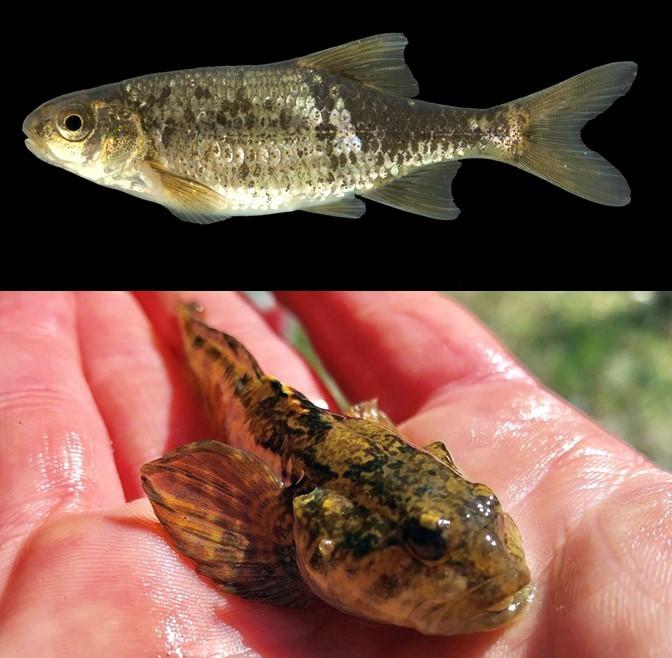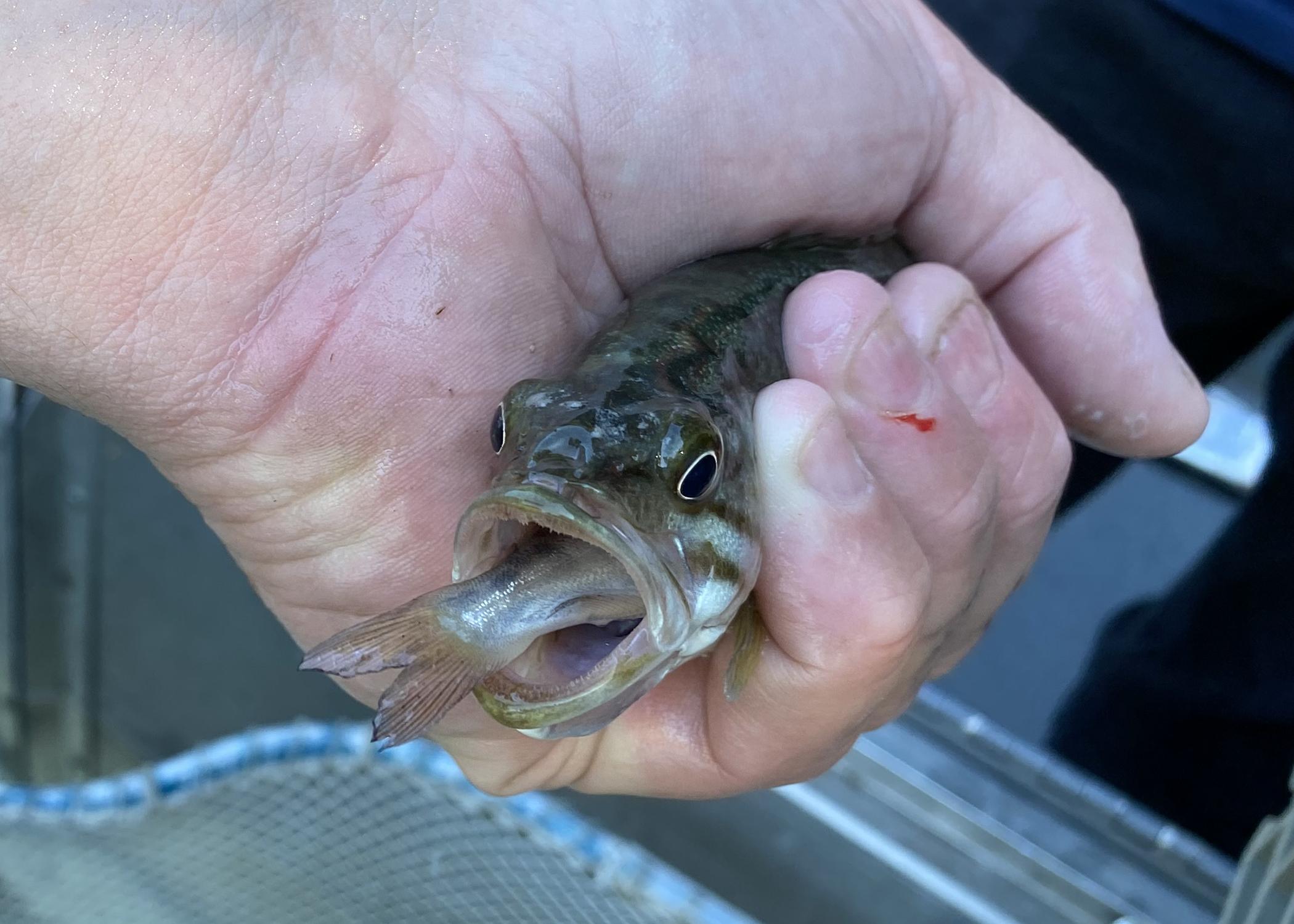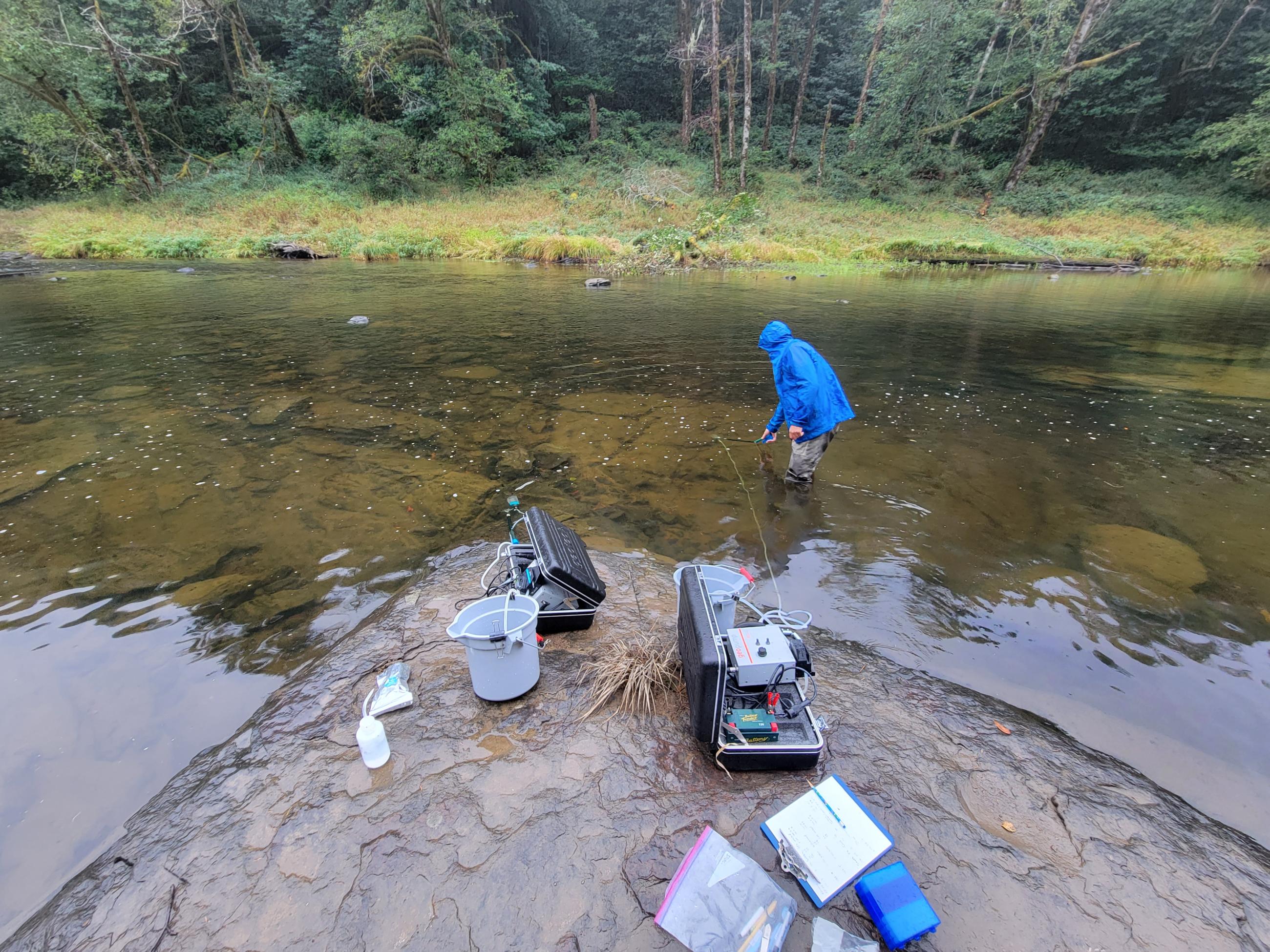The Oregon Biodiversity Genome Project
Over 70 native freshwater fishes call Oregon home. Some are found nowhere else in the world (Figure 1). All help to tell the unique story of Oregon’s freshwater biodiversity, but that story is not always easy to decipher. Some of these species require taxonomic revision, and many are difficult to identify based on their appearance (Fig. 1). As a result, we lack accurate distribution information for many of Oregon's more cryptic fish species, and this complicates assessment of their current status and vulnerability to emerging threats like climate change.

Figure 1. The Umpqua Chub (Oregonichthys kalawatseti) is just one of Oregon’s endemic fishes. Photo by Brian Sidlauskas, voucher specimen from the Oregon State University Ichthyology Collection (Top). (Bottom) Even skilled taxonomists have trouble identifying some of Oregon's native fish species like this sculpin, and field identification for some is virtually impossible. Photo by J.Anthony (Bottom).
In addition to Oregon’s native freshwater fishes, at least 50 non-native freshwater fishes now inhabit Oregon’s waters. Some are relatively common, widespread and well established, but others are relative newcomers with rare occurrences or patchy distributions. Early detection of new introductions can help managers respond, potentially preventing invasions from becoming established (Fig. 2).

Figure 2. The predacious Smallmouth Bass (Micropterus dolomieu) is not native to Oregon but has been introduced and established in the Columbia River and some of its tributaries in Oregon. Further spread of this species in Oregon’s waters could have significant economic and ecological impacts. For example, the recent illegal introduction of Smallmouth Bass into the Coquille River on the Oregon coast has resulted in the near extirpation of the native fall Chinook Salmon run. Photo: ODFW
Environmental DNA (eDNA) is a promising new addition to biologists’ monitoring toolkit. Environmental DNA refers to DNA that is shed by organisms and then recovered in water, sediment, or soil samples (Fig. 3). Linking eDNA back to the source organisms using genetic sequence data can provide efficient and non-invasive detection of a species. Development of eDNA monitoring tools requires known genetic sequences of each target species and closely related and co-occurring species. Despite considerable research and development of eDNA-based detection techniques, the lack of genetic sequence data for many of our fishes currently limits the use of eDNA as a method for species detection in Oregon.

Figure 3. A REDD biologist samples eDNA by filtering water from an Oregon coastal stream. In the laboratory, the DNA is extracted from the filter, and an eDNA assay (test) can determine if a DNA from a target species was present in the sample. Photo by J. Anthony.
To address the limited availability of genetic sequence data for Oregon’s fish and wildlife, researchers at Oregon State University, the Oregon State University Ichthyology Collection, the U.S. Forest Service and the ODFW REDD Group partnered to create the Oregon Biodiversity Genome Project (OBGP; OBGP.org). The goal of the OBGP is to build a comprehensive library of complete mitochondrial genetic sequences matched to expertly identified voucher specimens of Oregon’s fish species. This ambitious effort requires field samplers to obtain genetic samples from all of Oregon's fish species. With these samples, geneticists sequence complete mitochondrial genomes so that eDNA can be matched to the species in our waters.
OBGP Project Partners
Oregon State University
- Emily Dziedzic, Department of Fisheries and Wildlife
- Taal Levi, Department of Fisheries and Wildlife
- Brian Sidlauskas, OSU Ichthyology Collection
- Peter Konstantinidis, OSU Curator of Vertebrates
ODFW REDD Group
- Jamie Anthony, REDD Program Manager
- Trevan Cornwell, Biologist
PNW Research Station, USFS
- Rich Cronn, Research Geneticist
- Brooke Penaluna, Research Fish Biologist
- Laura Hauck, Biological Science Technician
- Bruce Hansen, Ecologist
Development of this foundational genetic sequence library requires collection of tissue samples and voucher specimens from all fish species residing in Oregon. Since 2017, biologists from REDD, 7 other ODFW programs, the U.S. Forest Service, Klamath Tribes, Oregon Department of Environmental Quality, and Oregon State University have collected nearly 700 voucher specimens and tissue samples from 241 unique sites (Fig. 4). Additional samples have been obtained from the Oregon State University Ichthyology Collection.
With these samples, the OBGP has already built a near-comprehensive library of complete mitochondrial genetic sequences matched to expertly identified voucher specimens of Oregon’s fish species. To-date, this includes complete mitogenomes of representing 24 families, 55 genera and 129 species and lineages. This has been accomplished at a fraction of the time and cost that many expected, and these data are already providing a basis for developing new tests (eDNA assays), which will match eDNA collected in field samples to the corresponding species in Oregon waters.

Figure 4. From desert to city and everywhere in between, REDD biologists and OBGP partners scoured Oregon’s waters to find Oregon's fish species, whether common or rare. Photos by Trevan Cornwell.
The OBGP data have already been put to use. OBGP data are being used by the U.S. Forest Service Pacific Northwest Research Station to develop multi-species eDNA detection methods in Oregon coastal basins, researchers at Oregon State University are piloting multi-species approaches in Oregon's Goose Lake basin, and data have been used to develop eDNA assays for Sacramento Sucker and Modoc Sucker, a species recently de-listed from the federal Endangered Species Act. The OBGP has also worked to develop new eDNA assays for Umpqua Chub, Bull Trout, and Brook Trout based on analysis of complete mitochondrial sequences, and OBGP data has helped to identify a new lineage of Paiute Sculpin (Cottus beldingii ssp.) in the John Day River Basin in central Oregon.
The OBGP has used this experience to publish a roadmap providing other researchers with the basic steps to follow to create their own regional database to support development of eDNA methods for other target taxa and geographies:
- Dziedzic, E., B. Sidlauskas, R. Cronn, J. Anthony, T. Cornwell, T. Friesen, P. Konstantinidis, B. Penaluna, S. Stein and T. Levi. 2023. Creating, curating and evaluating a mitogenomic reference database to improve regional species identification using environmental DNA. Molecular Ecology Resources 23(8):1880-1904. doi:10.1111/1755-0998.13855
Data Accessibility. All genomic data from this project are freely available to researchers for the development of novel molecular methods for environmental monitoring and phylogenetic analysis. Genetic sequence data are available at the OBGP website (here) or under the Oregon Biodiversity Genome Project BioProject at Genbank, the National Institute of Health genetic sequence database (here).
Check out the OBGP website at www.OBGP.org or follow the OBGP on Instagram for more information and the latest updates from the lab.
For more information about field collections, how the ODFW REDD group is working with the OBGP, or to explore how you can provide assistance with collection efforts, contact: